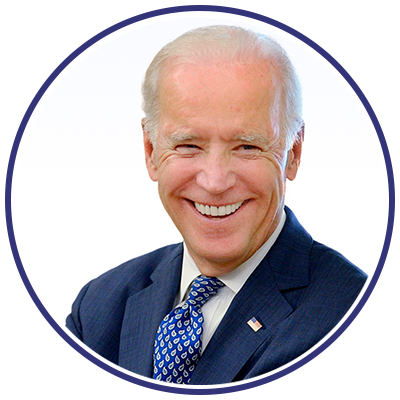2020 Policy Tracker: Opportunity
Racial Wealth Gap

Joe Biden
Joe Biden addresses the racial wealth gap in “The Biden Plan for Strengthening Worker Organizing, Collective Bargaining, and Unions”. His plan will “increase the federal minimum wage to $15” and “index the minimum wage to the median hourly wage so that low-wage workers’ wages keep up with those of middle income workers.”
In “The Biden Plan to Invest in Middle Class Competitiveness”, he will:
-
“Expand the New Markets Tax Credit, make the program permanent, and double Community Development Financial Institutions (CDFI) funding.”
-
“Double funding for the Economic Development Administration.”
-
Create a new fund to support the establishment and revitalization of anchor institutions which can be a source of good jobs in low-income areas.
Additionally, in his “Build Back Better” plan, Biden will:
-
“Expand access to $100 billion in low-interest business loans.”
-
“Eliminate barriers to technical assistance and advisory services.”
-
“Spur more than $50 Billion in New Equity Investment and Venture Capital for Entrepreneurs in Economically Disadvantaged Areas.”
-
“Dramatically increase the availability of venture capital investments for small businesses, especially those owned by Black and Brown people.”
-
“Encourage private equity investment in businesses owned by Black and Brown people by expanding the New Markets Tax Credit (NMTC) to $5 billion yearly and making it permanent.”
-
-
“Leverage $100 Billion in Additional Financing for Small Businesses.”
-
“Expand lending through the expanded Small Business Opportunity Fund.”
-
“Capitalize Community Development Financial Institutions.”
-
“Ensure all small business relief efforts are specifically designed to aid businesses owned by Black and Brown people.”
-
“Strengthen and expand the Community Reinvestment Act to ensure that our nation’s bank and non-bank financial services institutions are serving all communities.”
-
-
“Expanding Access to Additional Resources and Technical Assistance for Black and Brown Entrepreneurs.”
-
“Create a national network of federally funded small business incubators and innovation hubs.”
-
“Establish an intensive, semester-long business development program at every public community college in the United States, as well as two-year HBCUs, TCUs, and MSIs.”
-
“Increase the funding and stature of the Minority Business Development Agency (MBDA).”
-
“Unleash the full potential of businesses owned by Black and Brown people and other disadvantaged businesses to participate in the global marketplace.”
-
“Employ the resources of the federal government to protect Native artisans.”
-
-
“Reform opportunity zones to ensure they serve black and brown communities, small businesses, and homeowners.”
-
“Require prime contractors to develop and execute plans to increase subcontracting opportunities for small disadvantaged businesses (SDBs).”
-
“Expand long-term technical assistance and federal contracting preferences for small disadvantaged businesses.”
-
“Incentivize state and local governments and private sector partners to contract with small disadvantaged businesses.”
-
“Protect small disadvantaged businesses from federal and state contract bundling which often prevents smaller firms owned by Black and Brown people from effectively bidding on procurement contracts.”
-
“Strengthen implementation of the Buy Indian Act.”
-
“Boost Retirement Security and Financial Wealth for Black, Brown, and Native Families.”
-
“Equalize the tax benefits of defined contribution plans.”
-
“Give small businesses a tax break for starting a retirement plan and giving workers the chance to save at work.”
-
“Open the door for Asset Managers owned by Black and Brown people.”
-
-
“Ensure workers of color are paid fairly.”
-
“End pay discrimination.”
-
“Increase the federal minimum wage to $15 across the country and eliminate the minimum tipped wage.”
-
“Stop employers from denying workers overtime pay they’ve earned.”
-
-
“Empower the Equal Employment Opportunity Commission to fulfill its mission and address workplace discrimination.”
-
“Make it easier for workers of all color and all workers to organize unions and bargain collectively.”
-
“Address longstanding inequities in agriculture.”
-
“Establish an Equity Commission.”
-
“Farm Land Purchase Assistance Program.”
-
“Protect Heirs Property.”
-
“Establish a Farmland Trust.”
-
“Advance Community Supported Agriculture (CSA).”
-
“Advance fairness, accountability, and transparency at the United States Department of Agriculture.”
-
“Expanding protections for farm workers.”
-

Donald Trump
Donald Trump’s campaign platform does not address the racial wealth gap, but his “Economy And Jobs“ issue page discusses his job creation progress. It highlights:
-
An executive order he signed that “expanded federally funded apprenticeship programs and on-the-job training”, stating The Workforce Development Advisory Council has already created on-the-job training opportunities for 6.5 million Americans.
-
“Hispanic, Asian and African American unemployment rates have all reached record lows due to his pro growth policies.”
